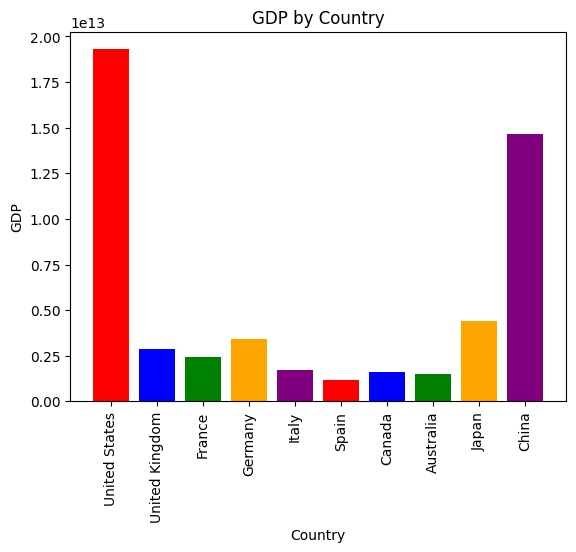PANDASAI documentation
pandas AI is a Python library that enhances Pandas with generative AI capabilities.
It is intended to complement, not replace, the popular data analysis and manipulation tool.
Using pandasai, users are able to summarise pandas dataframes data by interacting like Human.
Check out the Getting Started section for instructions including how to install the package.
This project is under active development.
PandasAI 🐼
Pandas AI is a Python library that adds generative artificial intelligence capabilities to Pandas, the popular data analysis and manipulation tool. It is designed to be used in conjunction with Pandas, and is not a replacement for it.

Demo
Try out PandasAI in your browser:
Documentation
The documentation for PandasAI can be found here.
Installation
pip install pandasai
Usage
Disclaimer: GDP data was collected from this source, published by World Development Indicators - World Bank (2022.05.26) and collected at National accounts data - World Bank / OECD. It relates to the year of 2020. Happiness indexes were extracted from the World Happiness Report. Another useful link.
PandasAI is designed to be used in conjunction with pandas. It makes Pandas conversational, allowing you to ask questions about your data and get answers back, in the form of pandas DataFrames. For example, you can ask PandasAI to find all the rows in a DataFrame where the value of a column is greater than 5, and it will return a DataFrame containing only those rows:
import pandas as pd
from pandasai import PandasAI
# Sample DataFrame
df = pd.DataFrame({
"country": ["United States", "United Kingdom", "France", "Germany", "Italy", "Spain", "Canada", "Australia", "Japan", "China"],
"gdp": [19294482071552, 2891615567872, 2411255037952, 3435817336832, 1745433788416, 1181205135360, 1607402389504, 1490967855104, 4380756541440, 14631844184064],
"happiness_index": [6.94, 7.16, 6.66, 7.07, 6.38, 6.4, 7.23, 7.22, 5.87, 5.12]
})
# Instantiate a LLM
from pandasai.llm.openai import OpenAI
llm = OpenAI(api_token="YOUR_API_TOKEN")
pandas_ai = PandasAI(llm, conversational=False)
pandas_ai(df, prompt='Which are the 5 happiest countries?')
The above code will return the following:
6 Canada
7 Australia
1 United Kingdom
3 Germany
0 United States
Name: country, dtype: object
Of course, you can also ask PandasAI to perform more complex queries. For example, you can ask PandasAI to find the sum of the GDPs of the 2 unhappiest countries:
pandas_ai(df, prompt='What is the sum of the GDPs of the 2 unhappiest countries?')
The above code will return the following:
19012600725504
You can also ask PandasAI to draw a graph:
pandas_ai(
df,
"Plot the histogram of countries showing for each the gpd, using different colors for each bar",
)

Additionally, you can also pass in multiple dataframes to PandasAI and ask questions relating them.
import pandas as pd
from pandasai import PandasAI
employees_data = {
'EmployeeID': [1, 2, 3, 4, 5],
'Name': ['John', 'Emma', 'Liam', 'Olivia', 'William'],
'Department': ['HR', 'Sales', 'IT', 'Marketing', 'Finance']
}
salaries_data = {
'EmployeeID': [1, 2, 3, 4, 5],
'Salary': [5000, 6000, 4500, 7000, 5500]
}
employees_df = pd.DataFrame(employees_data)
salaries_df = pd.DataFrame(salaries_data)
llm = OpenAI()
pandas_ai = PandasAI(llm)
pandas_ai([employees_df, salaries_df], "Who gets paid the most?")
The above code will return the following:
Oh, Olivia gets paid the most.
You can find more examples in the examples directory.
Command-Line Tool
Pai is the command line tool designed to provide a convenient way to interact with PandasAI through a command line interface (CLI).
pai [OPTIONS]
Options:
- -d, --dataset: The file path to the dataset.
- -t, --token: Your HuggingFace or OpenAI API token, if no token provided pai will pull from the
.envfile. - -m, --model: Choice of LLM, either
openai,open-assistant,starcoder, or Googlepalm. - -p, --prompt: Prompt that PandasAI will run.
To view a full list of available options and their descriptions, run the following command:
pai --help
For example,
pai -d "~/pandasai/example/data/Loan payments data.csv" -m "openai" -p "How many loans are from men and have been paid off?"Should result in the same output as the
from_csv.pyexample.
Privacy & Security
In order to generate the Python code to run, we take the dataframe head, we randomize it (using random generation for sensitive data and shuffling for non-sensitive data) and send just the head.
Also, if you want to enforce further your privacy you can instantiate PandasAI with enforce_privacy = True which will not send the head (but just column names) to the LLM.
Environment Variables
In order to set the API key for the LLM (Hugging Face Hub, OpenAI), you need to set the appropriate environment variables. You can do this by copying the .env.example file to .env:
cp .env.example .env
Then, edit the .env file and set the appropriate values.
As an alternative, you can also pass the environment variables directly to the constructor of the LLM:
# OpenAI
llm = OpenAI(api_token="YOUR_API_KEY")
# Starcoder
llm = Starcoder(api_token="YOUR_HF_API_KEY")
License
PandasAI is licensed under the MIT License. See the LICENSE file for more details.
Contributing
Contributions are welcome! Please check out the todos below, and feel free to open a pull request. For more information, please see the contributing guidelines.
After installing the virtual environment, please remember to install pre-commit to be compliant with our standards:
pre-commit install
Acknowledgements
- This project is based on the pandas library by independent contributors, but it's in no way affiliated with the pandas project.
- This project is meant to be used as a tool for data exploration and analysis, and it's not meant to be used for production purposes. Please use it responsibly.
Todo
- [ ] Add support for more LLMs
- [x] Make PandasAI available from a CLI
- [ ] Create a web interface for PandasAI
- [ ] Add unit tests
- [x] Add contributing guidelines
- [x] Add CI
- [x] Add support for conversational responses


